What are Cancer Clinical Trials?
NOV 28, 2022Clinical Trials are research studies that involve people. Through clinical trials, doctors find new ways to improve treatments and the ...
Read More
Imagine the ability to grow your own skin – in a lab. It’s a particularly exciting breakthrough for burn patients and the experts who treat them. Surgeons & researchers at CHI Health St. Elizabeth Regional Burn and Wound Center are participating in research for the treatment of deep burns comprising total body surface area ranging from 30 to 90%. This research innovation involves growing skin for patients using their own skin cells.
It starts with a small graft of healthy skin the size of a postage stamp taken from the patient. This biopsy then goes through a sophisticated culture process to promote cell growth and eventual creation of sufficient numbers of sheets of skin that can be grafted on the affected patient, in effect restoring the vital skin covering that a person needs to survive. As the only verified burn center in Nebraska, the CHI Health St. Elizabeth Regional Burn and Wound Center is committed to participating in research and innovation to provide the best possible treatment to every patient that comes into their care.
What these physicians and researchers know, and many people don’t realize, is that the skin of the human person is an incredible part of the body structure. It is the largest organ of the body -- accounting for up to 15 percent of a person’s total body weight. It guards the underlying muscles, bones, and internal organs, and provides insulation, temperature regulation and sensory capabilities.
Burn wounds and trauma constitutes one of the most serious attacks to the skin of a person, especially when the burn areas is severe, deep and large. Burn damage to skin is most significant because it causes skin cells to die. People can easily recover from small or non-serious burns. However, serious burns require immediate emergency care to prevent complications and death.
Long-term survival and quality of life for the severe burn trauma patients often requires surgical therapy to replace damaged skin. This involves excision or removal of necrotic or damaged skin, and covering the wound as soon as possible.
Many different techniques can be used to provide the covering once damaged skin is removed. These include harvesting undamaged skin from another part of the body, using cadaver skin as temporary covering, or using fabricated dermal regeneration products (skin substitutes). However, in some cases these techniques are not an option or can prove to be ineffective.
The ability to grow skin from a patient’s own cells – particularly from a small graft -- represents a significant advance and addition to the treatment options available to burn patients.

Clinical Trials are research studies that involve people. Through clinical trials, doctors find new ways to improve treatments and the ...
Read More
If you’ve ever wondered what happens when your doctor sends something to the lab, here’s the secret: it ends up ...
Read More
If you have heart failure, you know slowing the progression of the disease can add time to your life. That’s why ...
Read MoreWhen you need local health information from a trusted source, turn to the CHI Health Better You eNewsletter.